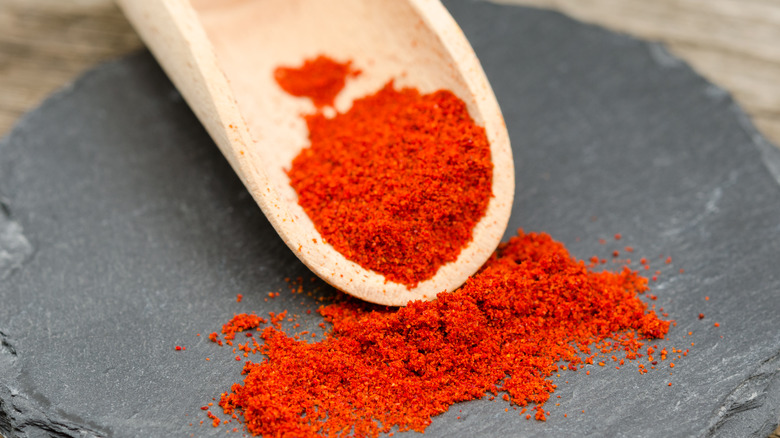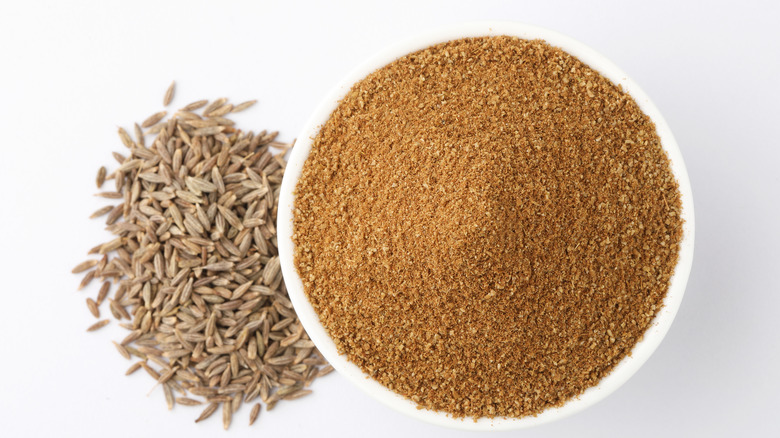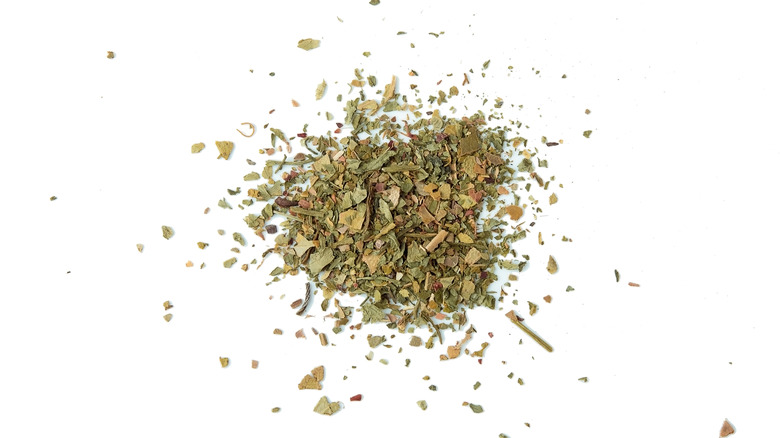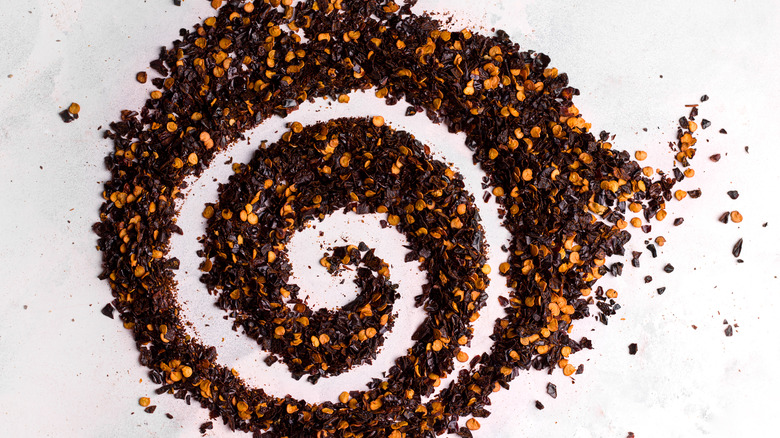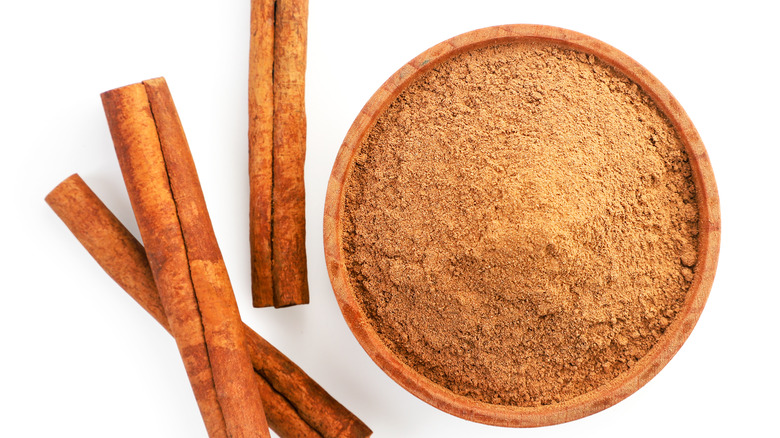These Are Sunny Anderson's Top 5 Must Have Seasonings
If one thing holds true, it is that avid home cooks love to experiment with different flavor profiles and dishes. What exactly does this mean? Their spice racks are more than likely brimming and teeming with different dried herbs and spices that they've found at their local grocer, supermarket, or farmer's market. Another thing that holds true about home cooks is that they are constantly wondering what their favorite chefs are using when they cook at home for their families.
In a tweet from a fan, famed chef and TV personality Sunny Anderson was asked her favorite dried herbs and seasonings that she always has on hand at home (the fan noted that salt and pepper are a given). The Kitchen co-host admitted that her top five dry spices and herbs to have on hand are hot Hungarian paprika, cumin, homemade Italian seasoning, ancho chili powder, and cinnamon. She also gave the fan tips on how to make her spin on Italian seasoning, which also includes garlic and lemon peels.
Hot Hungarian paprika works well when you want to add a little kick to your dish
You might not be aware that there are more than two types of paprika, and Sunny Anderson happens to love the spicy variety that hails from Hungary. Chili peppers were one of the many things brought back to Europe from the New World by Christopher Columbus, but they didn't make it to Hungary until the Turks arrived in the country, per Pepper Scale. According to The Kitchn, Hungarian paprika is seen as the country's national spice and has eight subcategories: különleges, which is mild and a vivid red; csípősmentes csemege, which is more delicate in flavor; csemege paprika, which is mild and pungent; csípős csemege, the most pungent in the pack; édesnemes, which is sharp red and slightly pungent; félédes, which is semi-sweet; rózsa, a paler red; and erős, the spiciest of the bunch that ranges from a light brown color to an orangy one.
What makes the Hungarian variety of paprika so different from smoked and regular paprika? Bon Appetit says it is way more complex in flavor — like comparing a pop song to one of Beethoven's many classics. Savory Spice Shop notes that Hungarian paprika can be enjoyed in anything from goulash, chicken paprikash, and barbecue rubs; it can also be used as a garnish.
Add cumin if you'd like an earthy taste in your meal
Cumin has been around for quite some time and can be found in both the Old Testament and New Testament of the Bible. It is a seed that hails from the parsley family and is normally a brown-yellow color. This mighty little seed is normally sold in either seed form or crushed into a powder and makes a great component to any chili, barbecue sauce, soup, or marinade.
Cumin is oftentimes used within Latin American, Middle Eastern, North African, and Indian cuisines. Cumin imparts a warm, musky, and earthy flavor profile to the foods that it is used with and does not possess any kind of spice level. An added bonus of using cumin in your recipes? It has some potential health benefits, per Medical News Today. The publication notes that cumin may support things like weight loss, controlling cholesterol and sugar levels, and stress.
Homemade Italian seasoning can add a sweet and delicate flavor profile to almost any dish
Whether it be for fresher tasting food or more control over what goes into your meals, there is something to be said about making things at home. Italian seasoning is a mixture of herbs that add a delicate and earthy flavor profile to whatever you are cooking, per The Food Network. So what exactly is Italian seasoning made of? Typically, herbs like basil, oregano, thyme, rosemary, and marjoram are used, according to Paesana. A benefit of making your own batch at home is that you can add more herbs in addition to the base herbs; things like sage, red pepper flakes, fennel, and parsley can be incorporated as well.
Despite incorporating herbs that are typically used within Italian cuisine, the jury is still out on exactly where Italian seasoning originated from. The Food Network notes there are some that say that it is an Italian invention, while others claim it to be an American invention. Regardless of where it's from, The Recipe Critic underlines that Italian seasoning is great as a toasted bread topping, in things like pasta and soup, as the base for a dressing or a marinade, and on pizza.
Ancho chili powder works well with all types of meats
Not to be confused with chili powder, ancho chili powder is made up of dried and ground ancho chiles, according to Fine Cooking. While ancho chili powder can be purchased at your local grocer or supermarket, Culinary Hill says that making it at home is not only easy but all-around cheaper. To make it, all you need are some ancho chilis, a spice grinder (or a mortar and pestle), and a sifter (for sifting out the bigger pieces). Start by removing the stems and seeds, then grind the chiles into powder.
Ancho chiles are ripened poblano peppers (they go from green to red when ripe) and come from the state of Puebla, Mexico, per Chili Pepper Madness. Despite its spicy origins, Culinary Hill notes that ancho chili powder is considered a mild spice and reaches no more than 2,000 Scoville heat units overall. What can it be used in? Anything you'd like to add a little heat to, like soups, marinades, and barbecue sauces. It also works well with meats like chicken, beef, pork, and venison.
Cinnamon works well on both sweet and savory dishes
Last, but definitely not least, is cinnamon. Per Everyday Health, cinnamon is an ancient spice that can be found on evergreen trees that belong to the laurel family and is a very popular spice in Asia, Europe, and North America. Like cumin, cinnamon dates back to Biblical times and has been used by ancient Egyptians, Romans, and Hebrews for religious ceremonies. While there are several types of cinnamon, the most common one sold in North America is a Chinese variety named Cinnamomum cassia. But Delish notes that only Ceylon cinnamon (or Cinnamomum verum), which is from Sri Lanka, is considered to be the purest form of cinnamon.
Spoon University notes that cinnamon can be added to things like granola, hot cocoa, bacon, pancakes, and edamame. It's also a great spice to use with braised pork belly. Healthline notes that cinnamon has several potential health benefits like lowering the risk of heart disease, improving insulin sensitivity, and lowering blood sugar levels.

